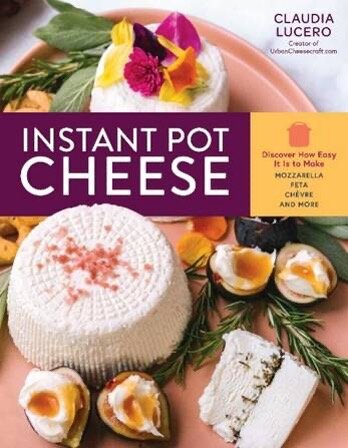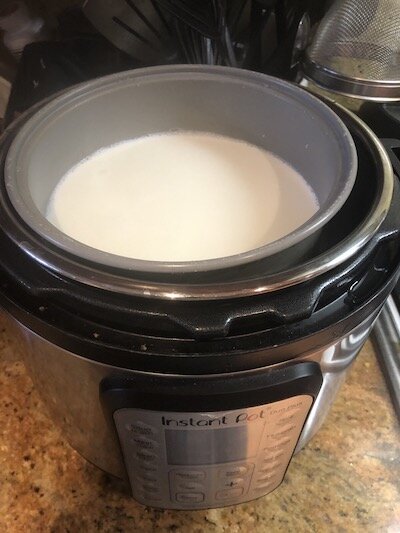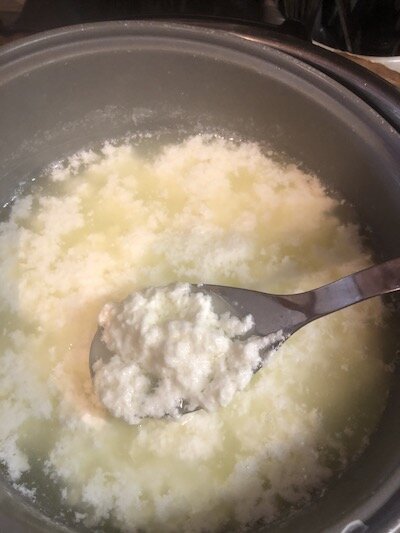Book Review: Instant Pot Cheese
The Instant Pot, a programmable “multicooker” famously makes everything from yogurt to rice to sauces and stews. One of the more surprising uses of the Instant Pot is cheesemaking, and author Claudia Lucero has mastered this art for Instant Pot Cheese: Discover How Easy It Is to Make Mozzarella, Feta, Chevre, and More. The owner of Urban Cheesecraft, a company providing DIY cheese kits, Lucero had already learned the art of making cheese in her home kitchen before authoring the Instant Pot book. The result is that “Instant Pot Cheese” is an informative, user-friendly dive into the world of relatively fast, stress-free cheese -- one that doesn’t yet seem to have a competitor on the market.
The Instant Pot: Your own mini dairy
“Having an Instant Pot is like having your own mini dairy facility at home,” Lucero writes in the cookbook introduction. After all, dairy curdles under pressure. But there’s much more to it than that. The Instant Pot makes heating milk at a near-constant temperature a much easier prospect, and having a sterile, closed-off space eliminates many of the mishaps of cheesemaking.
I felt apprehensive opening the book. Despite being a fervent cook and recipe tester, I’ve never even considered making cheese at home -- that is, beyond some paneer I tied to the sink for an Indian dinner at my college co-op. Cheese, in my head, has always been something for the gods of Olympus to ferment and benevolently bestow upon us. I’ve always left the magic and mystery of producing the world’s most delicious and addictive food to the masters at Murray’s, as well as those mythical herders roaming the green hillsides of Basque terrain with their fluffy sheep. Lucero’s cookbook set me at ease right away. Flipping open the book feels like reading a friendly graphic novel, replete as it is with illustrations of happy illustrated Instant Pots, strainers, and measuring spoons. I’m fairly confident with my Instant Pot, and I know how to use all the tools Lucero lists.
Lucero reassured me that I could avoid some of the common mishaps of cheesemaking -- boilovers, inconsistent heat, and even scorching at the bottom of the pot -- by strategically using an Instant Pot. I’m all about cooking smarter, so I was intrigued. Her central methodology comes down to this: creating a cooker within a cooker. For that, you’ll need an inner pot and a trivet -- by that, I mean a smaller three-quart vessel to place within your larger Instant Pot, and a trivet of some sort so that you can put water in your Instant Pot. Picture your six-quart Instant Pot (the most widely used), wherein you will place a stainless steel trivet at the bottom. You’ll pour one cup of water in your Instant Pot, and then perch a three-quart stainless steel pot or bowl with no plastic handles on top. That’s your main milk-boiling mechanism.
Instant Pot with milk
I used the bottom compartment of my small Moka Pot as a trivet and the insert of my small rice cooker as an inner bowl. I was lucky that it was just the right size to snap the lid on my six-quart pot, but you’ll need to test everything out before you set out on your cheesemaking mission to make sure the lid will close. For a trivet, try a stainless steel ramekin, a cookie cutter, the metal lid of a large jar, a small colander, a food mill screen, or even a small bamboo steamer basket. For the inner bowl, you can use whatever you have on hand that’s heatproof -- both ceramic and stainless steel bowls work -- or purchase a three-quart Instant Pot insert.
To make the cultured options in your cookbook, you’ll need a “Yogurt” function on your Instant Pot -- be aware that not all multicookers have this function, and check beforehand, or you’ll end up turning on your oven light or needing a large dehydrator to make coconut milk yogurt, buttermilk, fast feta, creme fraiche, quark, sour cream, whipped cream cheese, fromage blanc, and honey-lavender chevre. From there, you’re golden -- it’s mostly about ingredients after that. Know that some of the ingredients are a bit rarer than others. While I was able to find buttermilk, yogurt, and whole cow’s milk at my local big-box grocery store, finding goat’s milk was more of a challenge, especially raw. You’ll need rennet to make the mozzarella, feta, and chevre, and that’s something you can’t just find anywhere. I also found in general that I needed more lemon juice than specified to get the milk to curdle -- sometimes a lot more. The vegan cheeses are even more specific, requiring tapioca powder, agar powder, and almond flour.
Lucero recommends using raw milk. “Bacteria, lactose, enzymes, calcium, and fat are left intact in raw, or farm-fresh, milk, which turns cheesemaking into an easy and nutritious endeavor,” the cheesemaker writes. “Raw milk just wants to curdle.” Reading this, I had a flash remembrance of taking a grade school field trip to a dairy farm, where we milked cows and took turns shaking a jar of milk until it turned into butter. But I don’t have a reliable source for raw milk right now, so I used good old-fashioned grocery store pasteurized milk. What you don’t want if aesthetics are important to you, Lucero tells us, is ultra-pasteurized or lactose-free milk -- they’ll turn slightly brown.
I opted to make two fairly easy cow’s milk cheeses -- the whole milk ricotta and the herb lovers’ wheels. If you’re just making these simple recipes, a cheesecloth may not be absolutely necessary -- I actually used a thin mesh strainer with tiny holes that wouldn’t allow any of the curd to fall through.
Making Whole Milk Ricotta
The ricotta is a three-ingredient affair consisting only of whole milk, lemon juice and salt (cheese salt is optional, but would be overboard in my opinion, as you’re not aging ricotta). I halved the recipe to fit in my small rice cooker insert, and it worked perfectly. I set my Instant Pot on low pressure, set the time to zero, and let it heat up. When it was done, it beeped and I let steam naturally release for 15 minutes before venting -- this part is vital, according to Lucero, because you don’t want to open your vent right away and splatter milk all over the place. Instead, keep your vent closed for 15 minutes after cooking before you even attempt to open the vent.
Then you add lemon juice (I had to use almost twice the amount called for) and let it curdle. It’s magical watching the whey and curds separate, and you’ll want to reserve the whey to freeze or bake with (Lucero includes an entire page on what to do with the whey, from feeding chickens to making broth, smoothies, and even popsicles. Drain the curds into a cheesecloth-lined colander and allow it to rest. I used my ricotta in ravioli, and the results were impressively fresh and flavorful. I loved that I could make a classic Italian dish from scratch, including the cheese and the dough, and it would taste restaurant-quality instead of store-bought.
Making Herb Lovers’ Wheels
The herb lovers’ wheels are a similar process, but with the addition of buttermilk for coagulation and taste, and herbs added at every step of the process, from heating the milk to mixing the curds to decorating the end result. It’s sort of a fun choose-your-own-adventure, since Lucero leaves the herbs up to you -- you can even add chile pepper flakes if you want to spice things up. I also needed almost twice the lemon juice to get my grocery store milk to curdle. For molding my herbed cheeses into round shapes, I used small shallow glasses rather than ramekins, since we’ve broken all of ours. After resting in the fridge, I was able to pry them out of the glasses with a spatula, but I highly recommend ramekins with cheesecloth linings to make this part easier for you. I patted them a bit more into shape and then showered them in chopped dill, which resulted in a very pretty white cheese speckled with green herbs. If you have edible flowers, feel free to crown your herbed cheese with them for an even more picturesque result. The finished product was a fresh soft cheese with a gently molded shape that I could slice into, patting it onto crackers and toast. I absolutely loved spreading it onto a gourmet bagel and topping it with chopped toasted walnuts, spiced olive oil, and a drizzle of honey. This cheese also makes a nice complement to various fruits, from ripe, thinly-sliced tomato to fig halves, though the mascarpone Lucero includes would be even better.
The author includes a helpful troubleshooting page, wherein she goes over the possible reasons your curd did not set or why your cultured recipes are not as tangy or thick as expected. She also offers a helpful index and further cheese reading education. A list of resources would be better included in the beginning, since not every cook reads the entire book start to finish before beginning, including suppliers such as Vital Proteins for beef gelatin powder and New England Cheesemaking Supply Company for freeze-dried yogurt and buttermilk cultures and cheesemaking supplies.
This cookbook is an excellent start for home cooks intimidated by cheesemaking, and for Instant Pots lovers who are looking for yet another way to utilize this ultimate dodecahedron of kitchen appliances. Lucero is a fascinating character, being a self-starter from the most self-starting of all American cities, Portland, and as a reader, I longed for a more complete bio or history of her life, as well as some of her personal stories woven into each recipe.
Lucero has also written two other cookbooks, One-Hour Cheese, and One-Hour Dairy-Free Cheese, the latter of which I’m tempted to cook from once I master the various Instant Pot dairy-free cheeses. Perhaps Lucero’s second Instant Pot Cheese Cookbook will feature more complex or flavored cow’s milk cheeses, as well as a manchego and a blue cheese, which would certainly be more complicated processes requiring more space and equipment.





